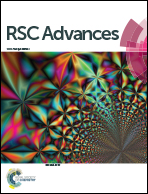Solvation chemistry through synergism: static and dynamic features of n-amyl alcohol–chloroform binary solvent mixture†
Abstract
The static and dynamic solvation behavior in a n-amyl alcohol (PtOH)–chloroform (CHCl3) binary solvent mixture was identified by steady state absorption, fluorescence quenching and picosecond streak camera studies, and also confirmed by a solvent exchange model. The evolution of synergistic solvation in the steady state absorption measurements was basically a result of solvent–solvent interactions via an extended intermolecular hydrogen bonding network. However, in the excited state, the desertion of such synergistic characteristics undoubtedly points towards the fragile nature of solvent networks present in the binary solvent mixture. It was believed and subsequently confirmed by the dynamics of the solvent response that the disruption of the weakly interactive solvent interactions is the core motivation for the absence of the synergism in the excited state. Surprisingly, we discovered the slowest dynamics in the binary mixture, with an average solvation time of 367.9 ps (in XPtOH = 0.43), which is much slower than the values for the pure solvents (〈τs〉n-amyl alcohol = 145.7 ps and 〈τs〉chloroform = 1.3 ps). The unexampled slowing of the solvation dynamics of C480 in the solvent mixture is believed to be owing to the inflexible combined solvent structure of n-amyl alcohol–chloroform in the first solvation shell around the solvatochromic molecule. As a consequence, such solvent immobility from the solvation shell subdues the molecular degree of freedom, resulting in a retardance of the fluorescence quenching process in the solvent mixture. Hence, the appearance of distinct solvation in the n-amyl alcohol–chloroform binary solvent mixture supplies a clear manifestation of solvent association interplay through weak hydrogen bonding which is believed to build up a unique solvation network compared to pure counterparts.



 Please wait while we load your content...
Please wait while we load your content...